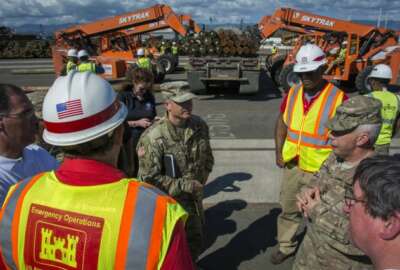
The Army Corps of Engineers helps landowners know where wetlands begin and end
The U.S. Army Corps of Engineers has started releasing a series of data sheets for the public. They show the delineations of wetland, a crucial piece of information...
Best listening experience is on Chrome, Firefox or Safari. Subscribe to Federal Drive’s daily audio interviews on Apple Podcasts or PodcastOne.
The U.S. Army Corps of Engineers has started releasing a series of data sheets for the public. They show the delineations of wetland, a crucial piece of information in land and resource management. Joining the Federal Drive with Tom Temin with details about the program, research soil scientist Jacob Berkowitz.
Interview transcript:
Tom Temin: Mr. Berkowitz, good to have you on.
Jacob Berkowitz: Thank you for having me, Tom, I’m happy to get the word out there about what is really a good news story for the U.S. Army Corps of Engineers and the American public.
Tom Temin: All right, so these data sheets that you are releasing, tell us what they depict, and who they’re intended to be received by?
Jacob Berkowitz: Yes, so the U.S. Army Corps of Engineers, as part of our mission is administration of the Clean Water Act. And under that responsibility, the Corps of Engineers reviews and makes permit decisions regarding over 70,000 proposed actions across the nation every year. And the vast majority of those actions require completion of a wetland delineation. As part of that delineation, the public or private sector practitioners collect data about soils, hydrology and vegetation to determine the presence of wetlands and the extent of those wetlands on the landscape. And so we’ve developed the tool, automated data forms, that expedite that process, increasing efficiency and accuracy for those 70,000 determinations every year.
Tom Temin: In other words, there are people out there that are trying to find this out already for purposes of projects, for example. And so they have measurements, I mean, what are some of the measurements you take, I can see a stream going by or the shore of lake, but it sounds like there’s more to determining what’s a wetland than simply visual?
Jacob Berkowitz: Yes, sir. Yes, there are specific characteristics that dictate the distribution of vegetation species that change the way the soil looks, and that provide evidence that wetland hydrology is present. That’s how we delineate wetlands. We look at those three factors. Now, the automated data sheets help to expedite that process by essentially automating the data collection and reporting process. And so that allows the Corps of Engineers to review permits faster and to get those permits out to the American public so they can move forward with building their projects as expediently as possible,
Tom Temin: Well give us a sample, an example of the type of project that might require knowing this and being able to get a determination from the Army Corps that might want to go in place somewhere.
Jacob Berkowitz: Yes, so the Corps of Engineers permits are required for any activities that result in the placement of fill within waters of the United States, including wetlands. So for example, if a developer wanted to expand the footprint of a neighborhood, and there was a possibility that that would have implications for wetlands or other aquatic resources, they’d be required to complete these wetland delineation activities in order to receive a permit and move forward with that project. And Tom, the take home message is that because there are so many of these actions that occur every year, anything that we can do to make those actions more expedient, and importantly, more accurate, helps the American public build the projects that they need to build, while ensuring that the Corps of Engineers are completing our mission and protecting natural resources.
Tom Temin: So it sounds like you’re trying to create a more objective reference for everybody as to where the wetlands begin and end?
Jacob Berkowitz: That certainly helps to accomplish that. Yes, it does. The automation that we’ve included with these data sheets really does help the public and private sector practitioners provide accurate information to the Corps of Engineers. And when we receive more accurate information, then we can turn those permits around more expeditiously to get the public what they need in terms of building these types of projects.
Tom Temin: We’re speaking with Jacob Berkowitz. He’s a research soil scientist in the environmental lab at the U.S. Army Corps of Engineers, and you’re speaking with us out of Vicksburg, Mississippi. And you collaborated with one of the other offices in developing this capability?
Jacob Berkowitz: That is correct, sir. Yes, the gentleman named Nathan Schulz, who works for the U.S. Army Corps of Engineers, Detroit district was instrumental in developing some of the coating that lies beneath the automated data sheets. So his work in particular really allowed us to develop a technology that had been elusive for a number of years in terms of doing the type of calculations that are required in these wetland delineation scenarios.
Tom Temin: And what is the source of the measurements? That is to say, is the automation in the creation of the data sheets? Or are there sensors throughout the country that are generating data all the time? How does that work?
Jacob Berkowitz: So this data is generated by folks who actually go out on site to a project site and complete evaluations. Historically, that was done on hard paper forms. And those paper forms had to be translated into an electronic format, and then submitted to the Corps for review. With the new automated data forms, what we’re hearing from the public as well as the private sector practitioners is that they’re able to complete those forms more quickly and more accurately, expediting the entire wetland delineation review process.
Tom Temin: Well, are there specific instruments, for example, to test the hydrology of a soil zone that you stick in the ground? And then what happens it measures something. And then how does that data get transmitted?
Jacob Berkowitz: We do use things like automated water table monitoring well, we also have things like chemical dyes that we can use in the soil. But in a typical context, Tom, it’s really just measurements of what plant community is there? What soil morphologies are we observing? And what signs of wetland hydrology can we physically see on the ground? So this isn’t a highly technical approach, because we do need it to be expedient. But we have found these methods over the years through a variety of research to be extremely reliable when appropriately applied.
Tom Temin: So these are observations, generally then, visual observations that are then recorded in some manner?
Jacob Berkowitz: That is correct. In a typical case, we collect these observations, and the automated data forms really help us to ensure the accuracy of that information. And ultimately, to expedite getting that information to the Corps in the appropriate fashion so that they can issue the permit and get them done. And just to give you an idea of the timelines associated with this, our goal is to try and get these permits turned around within 60 days. And for the general permits, we’re hitting that target more than 90% of the time. But if we can further expedite that process and get that number closer to 100%, that’s a benefit for the U.S. Army Corps of Engineers. And it’s a benefit for the American public.
Tom Temin: And what happens when there’s a dispute? For example, suppose there’s a certain bush or shrub that it’s growing, that indicates a wetland and the party, that’s the applicant can say, well, we also have this bush growing on dry grounds, it’s not wetlands. So how do we know what’s really wetlands? This kind of question, does that come up?
Jacob Berkowitz: Yes, Tom, that certainly comes up. And we have a very robust program where we try and work with applicants to get to the right technical answer to make sure that we’re in compliance with the regulations while also serving the public to the best of our ability. But there is a formal dispute resolution process that people can go through if there’s a disagreement about where those wetlands lie.
Tom Temin: And do you get a lot of cases of third parties trying to stop a development process? Because everybody has NIMBY (not in my backyard) in their lexicon.
Jacob Berkowitz: Certainly, you know, public access and public comment periods are a part of the permit process. And we welcome that feedback from the public to hear what they think about projects, so that we can make sure that we are administrating our responsibility under the Clean Water Act in efficient and responsible and expedient way.
Tom Temin: Now, once these automatic data sheets are determined for a given project, do they have any usefulness beyond that?
Jacob Berkowitz: Yes, they do. I mean, Tom we’re researchers here who develop these types of materials. And so we’ve used these automated data sheets extensively to conduct research across the country to help us get a better understanding of where wetlands are on the landscape. How those wetlands are changing over time? And what to expect to our natural resources, including wetlands, as we look forward to the challenges ahead of us, including the challenge of sea level rise and climate change.
Tom Temin: All right, Jacob Berkowitz is a research soil scientist in the environmental lab at the U.S. Army Corps of Engineers. Thanks so much for joining me.
Jacob Berkowitz: Thank you, Tom. It’s my pleasure to share this good news story with you and the public.
Copyright © 2024 Federal News Network. All rights reserved. This website is not intended for users located within the European Economic Area.
Tom Temin is host of the Federal Drive and has been providing insight on federal technology and management issues for more than 30 years.
Follow @tteminWFED




